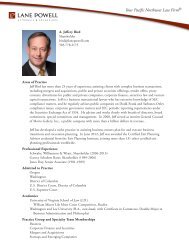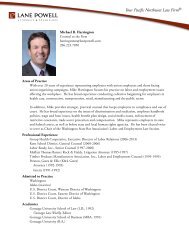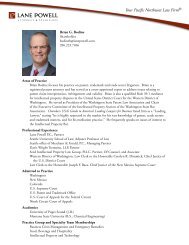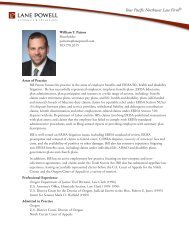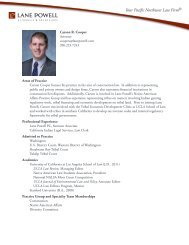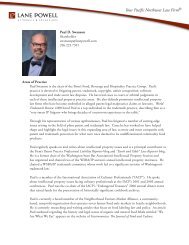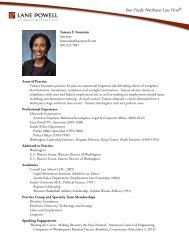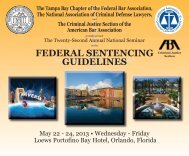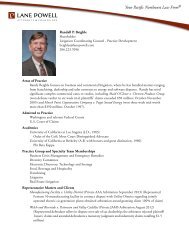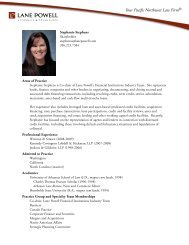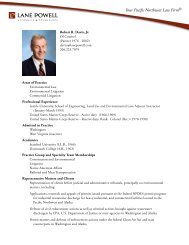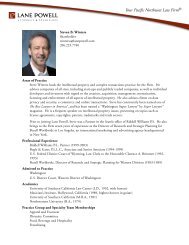portland's unreinforced masonry apartment buildings
portland's unreinforced masonry apartment buildings
portland's unreinforced masonry apartment buildings
You also want an ePaper? Increase the reach of your titles
YUMPU automatically turns print PDFs into web optimized ePapers that Google loves.
36 PORTLAND’S UNREINFORCED MASONRY APARTMENT BUILDINGS: A THREATENED SPECIES?<br />
other carriers including Mutual of Enumclaw and Rocky Mountain Fire have also withdrawn<br />
from the Oregon earthquake market. 3<br />
Commercial earthquake insurance is still available for URM <strong>buildings</strong> in Oregon through<br />
various carriers, in particular Lloyds of London, but coverage is expensive and is typically<br />
written through the “surplus lines market” as opposed to the more regulated “admitted<br />
market.” 4<br />
Commercial real estate lenders active in the Portland, Western Oregon and Southwest<br />
Washington mortgage market are becoming more conservative in making loans collateralized<br />
by URM <strong>buildings</strong>. Fannie Mae, Freddie Mac and HUD/FHA have since 2008 provided<br />
over 80 percent of all multifamily lending by dollar volume in the U.S. (Cassidy, 2010). However,<br />
the most accessible multifamily loan program from Fannie, Freddie and HUD, namely<br />
the popular Fannie Mae DUS (Delegated Underwriting and Servicing) loan program does<br />
not loan on URM <strong>buildings</strong> unless already seismically upgraded.<br />
In December 2006, Fannie Mae, in its DUS Program [Underwriting] Guide, imposed the<br />
following requirements on potential borrowers relative to seismic risk:<br />
1. Provide 100 percent full replacement cost earthquake insurance (maximum 10 percent<br />
deductible) as mitigation of the earthquake risk,<br />
2. Commission a Level I, Seismic Risk Assessment (PML Study) 5 for all loans over $20 million<br />
and for all loans on properties located in seismically active areas (Seismic Zones<br />
3 and 4), in particular (a) for even reinforced <strong>masonry</strong> if constructed prior to 1994, (b)<br />
for any building with a weak (soft) story at the first level above grade, such as glass<br />
storefronts. (Additional risks are identified for properties in Seismic Zone 4.)<br />
3. Achieve a PML of 20 or less, in other words, “The acceptable level of seismic risk is<br />
represented by a . . . PML at a 10 percent/50 year exceedance probability which does<br />
not exceed 20 percent.”<br />
Given the fact that an un-retrofitted URM might have a PML in the mid to high 30s, 6<br />
URM <strong>buildings</strong> are not acceptable for financing under the DUS program, at least in Seismic<br />
Zones 3 or 4 (Fannie Mae, 2006). Moreover, Fannie Mae representatives have indicated that<br />
although the DUS program will accept seismic upgrading of URM <strong>apartment</strong>s to satisfy the<br />
20 PML, it will do so only if the work is completed prior to loan funding.<br />
Other financial institutions offering <strong>apartment</strong> loans (principally banks) in Portland now<br />
are becoming somewhat cautious about loaning on URM <strong>apartment</strong>s. They typically require<br />
earthquake insurance. Some have underwriting guidelines which limit the loan to<br />
value ratio (LTV) and increase the debt service coverage (DSC) ratios on URM building<br />
loans. Conversations with several lenders suggest that although the interest rates and maturities<br />
offered URM owners are still competitive, principal amortizations may be faster and<br />
therefore less favorable (25 year versus 30 year), and personal guarantees of the principals<br />
of the borrower(s) will be standard.<br />
3 Author’s telephone conversation with CeCe Newell of the Oregon Insurance Division, May 27, 2010.<br />
4 Author’s telephone conversation with CeCe Newell of the Oregon Insurance Division, May 27, 2010.<br />
5 A term used in the insurance industry and commercial real estate. It is generally defined as the anticipated value<br />
of the largest loss that could result from the destruction and loss of use of the property. With regard to seismic<br />
risk, PMLs are typically performed according to the scope of work published by ASTM International (2007).<br />
6 Author’s conversations with Wade Younie, Structural Engineer, DCI Engineers (Winter, 2009–2010).




